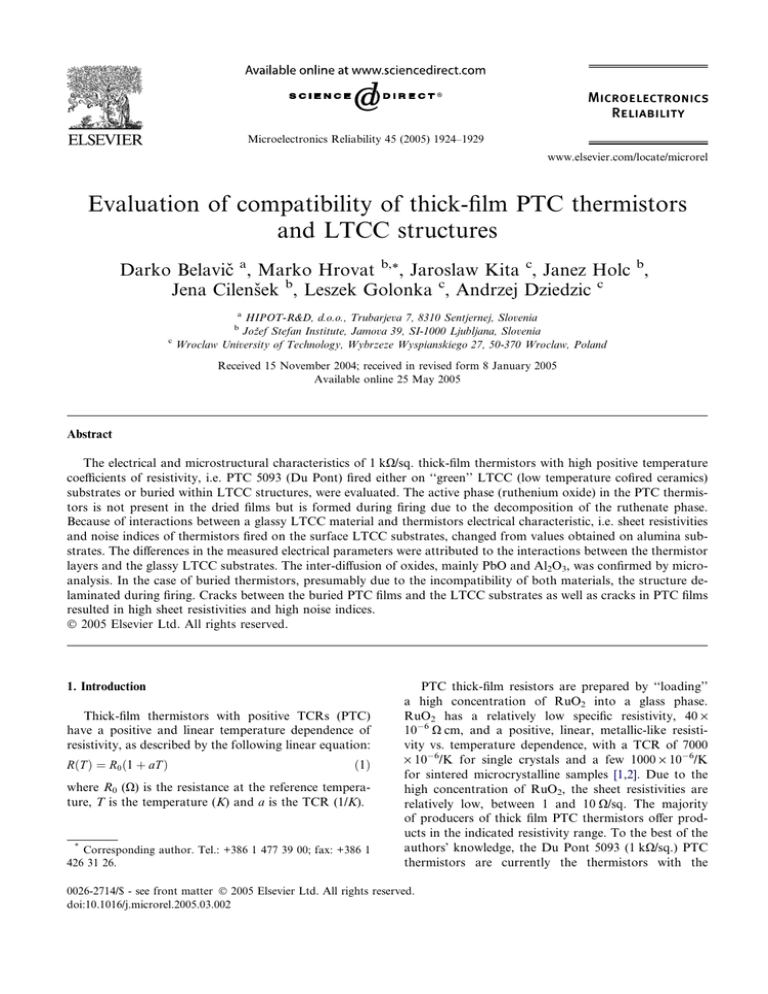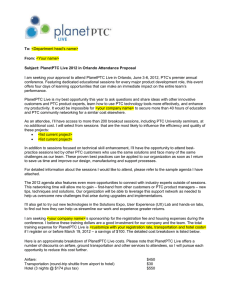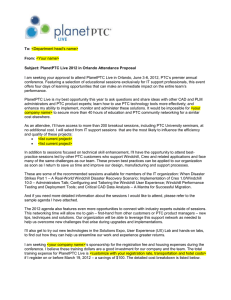
Microelectronics Reliability 45 (2005) 1924–1929
www.elsevier.com/locate/microrel
Evaluation of compatibility of thick-film PTC thermistors
and LTCC structures
Darko Belavič a, Marko Hrovat b,*, Jaroslaw Kita c, Janez Holc b,
Jena Cilenšek b, Leszek Golonka c, Andrzej Dziedzic c
a
HIPOT-R&D, d.o.o., Trubarjeva 7, 8310 Sentjernej, Slovenia
Jožef Stefan Institute, Jamova 39, SI-1000 Ljubljana, Slovenia
Wroclaw University of Technology, Wybrzeze Wyspianskiego 27, 50-370 Wroclaw, Poland
b
c
Received 15 November 2004; received in revised form 8 January 2005
Available online 25 May 2005
Abstract
The electrical and microstructural characteristics of 1 kX/sq. thick-film thermistors with high positive temperature
coefficients of resistivity, i.e. PTC 5093 (Du Pont) fired either on ‘‘green’’ LTCC (low temperature cofired ceramics)
substrates or buried within LTCC structures, were evaluated. The active phase (ruthenium oxide) in the PTC thermistors is not present in the dried films but is formed during firing due to the decomposition of the ruthenate phase.
Because of interactions between a glassy LTCC material and thermistors electrical characteristic, i.e. sheet resistivities
and noise indices of thermistors fired on the surface LTCC substrates, changed from values obtained on alumina substrates. The differences in the measured electrical parameters were attributed to the interactions between the thermistor
layers and the glassy LTCC substrates. The inter-diffusion of oxides, mainly PbO and Al2O3, was confirmed by microanalysis. In the case of buried thermistors, presumably due to the incompatibility of both materials, the structure delaminated during firing. Cracks between the buried PTC films and the LTCC substrates as well as cracks in PTC films
resulted in high sheet resistivities and high noise indices.
2005 Elsevier Ltd. All rights reserved.
1. Introduction
Thick-film thermistors with positive TCRs (PTC)
have a positive and linear temperature dependence of
resistivity, as described by the following linear equation:
RðT Þ ¼ R0 ð1 þ aT Þ
ð1Þ
where R0 (X) is the resistance at the reference temperature, T is the temperature (K) and a is the TCR (1/K).
*
Corresponding author. Tel.: +386 1 477 39 00; fax: +386 1
426 31 26.
PTC thick-film resistors are prepared by ‘‘loading’’
a high concentration of RuO2 into a glass phase.
RuO2 has a relatively low specific resistivity, 40 ·
106 X cm, and a positive, linear, metallic-like resistivity vs. temperature dependence, with a TCR of 7000
· 106/K for single crystals and a few 1000 · 106/K
for sintered microcrystalline samples [1,2]. Due to the
high concentration of RuO2, the sheet resistivities are
relatively low, between 1 and 10 X/sq. The majority
of producers of thick film PTC thermistors offer products in the indicated resistivity range. To the best of the
authorsÕ knowledge, the Du Pont 5093 (1 kX/sq.) PTC
thermistors are currently the thermistors with the
0026-2714/$ - see front matter 2005 Elsevier Ltd. All rights reserved.
doi:10.1016/j.microrel.2005.03.002
D. Belavič et al. / Microelectronics Reliability 45 (2005) 1924–1929
highest sheet resistivity values commercially available.
The above mentioned high resistivities are obtained
with materials, based on ruthenates with an addition
of copper oxide instead of ruthenium oxide [3,4]. It is
known that at high enough temperatures and/or long
enough time of firing the ruthenate conductive phase
in most ruthenate based thick film resistors decomposes
due to interactions with a glass phase into RuO2 and, for
example, PbO or Bi2O3 in the case of lead ruthenate or
bismuth ruthenate, respectively [5,6]. RuO2 crystallises
as equi-axed crystallites. This is shown schematically in
Fig. 1(a). The ‘‘real’’ microstructure of the ruthenate
based thick film resistor (8039, Du Pont) fired for 6 h
at 950 C, is shown in Fig. 1(b) [6]. Equi-axed RuO2
particles, denoted ‘‘R’’ and larger SiZrO4 grains denoted
‘‘SZ’’ can be observed.
The decomposition of the ruthenate phase depends
on the concentration of PbO in the glass, i.e. the lower
Fig. 1. (a) After high enough temperatures and/or long enough
time of firing the ruthenate conductive phase in thick film
resistors decomposes due to interactions with a glass phase into
RuO2. RuO2 crystallises as equi-axed crystallites (schematically). (b) TEM micrograph of ruthenate based 8039 thick film
resistor fired for 6 h at 950 C. RuO2 particle are, denoted ‘‘R’’
and larger SiZrO4 particles are denoted ‘‘SZ’’ [6].
1925
the concentration of the PbO in the glass the lower the
temperature of the decomposition will be [7,8]. Usually,
rather high temperatures and long firing times (e.g.
950 C and a few hours) are required for ‘‘normal’’,
low-TCR ruthenate-based-resistors, the characteristics
of which have to be reasonably independent of the processing parameters for the phase transformation of the
conductive phase from the ruthenate to the RuO2 to
take place.
However, the same transformation is essential for the
electrical characteristics, i.e. the high, positive and linear
TCR of the 5093 PTC resistors, which are fired at 850 C
for only 10 min. As mentioned above, a lower concentration of PbO in the glass phase enhances the decomposition of the ruthenates. The molar ratio SiO2/PbO is
around 2 for low TCR thick film resistors while it is
around 4 for 5093 PTC thermistors [9]. A relatively
low concentration of lead oxide means that the reaction
between the ruthenate and the glass occurs at lower
firing temperatures, i.e. at 850 C. Due to added copper
oxide, RuO2, which is formed due to the decomposition
of ruthenate, crystallises in the form of needle-like
grains, which form the conducting network through
the glass matrix. This is a result of a specific crystallographic relationship between the CuO and the RuO2
[10]. This is shown schematically in Fig. 2(a). The microstructure of the 5093 thermistor fired for 10 min at
850 C is shown in Fig. 2(b) [9]. Needle-like RuO2
grains are denoted ‘‘R’’ and SiZrO4 particles are denoted
‘‘SZ’’.
The PTC characteristics of the 5093 thermistors are
therefore due to the formation of elongated RuO2 needle-like crystals during firing and not as a result of the
original composition, i.e. ruthenate, copper oxide and
glass in the thermistor paste.
Ceramic multi-chip modules (MCM-Cs) are multilayer substrates with buried conductor lines, which mean
they have a high density of interconnections. Low-temperature co-fired ceramic (LTCC) materials, which are
sintered at the low temperatures typically used for
thick-film processing, i.e. around 850 C, are widely used
for the production of MCM-Cs, especially for telecommunications and automotive applications. LTCCs are
either based on crystallisable glass or a mixture of glass
and ceramics [11,12]. Thick-film resistors with high
TCRs are of interest as temperature sensors in MCMCs as well as in MEMS (Micro Electro Mechanical Systems) [13–15].
As the thick-film PTC thermistors are developed for
firing on alumina substrates, their compatibility and
interactions with the rather glassy LTCC substrates,
leading to changes in the electrical characteristics, needs
to be evaluated. The aim of this paper is to study the
characteristics of thick-film PTC 5093 thermistors fired
on Du Pont LTCC 951 substrates. Characteristics of
PTC thermistors fired on alumina substrates [9] are used
1926
D. Belavič et al. / Microelectronics Reliability 45 (2005) 1924–1929
current noise was measured in dB on 100-mW loaded
resistors using the Quan Tech method (Quan Tech
Model 315-C).
For the microstructural investigation the samples
were mounted in epoxy in a cross-sectional orientation
and then cut and polished using standard metallographic
techniques. A JEOL JSM 5800 scanning electron microscope (SEM) equipped with an energy-dispersive X-ray
analyzer (EDS) was used for the overall microstructural
and compositional analysis. Boron oxide, which is also
present in the glass phase, cannot be detected in the
EDS spectra because of the low relative boron weight
fraction in the glass and the strong absorption of the
boron Ka line during EDS analysis in the glass matrix.
Dried thermistors (150 C) and thermistors fired at
850 C were analysed by X-ray diffraction (XRD) analysis with a Philips PW 1710 X-ray diffractometer using
CuKa radiation.
3. Results and discussion
Fig. 2. (a) The ruthenate conductive phase in thick film
resistors decomposes due to interactions with a glass phase
into RuO2. Due to added copper oxide RuO2 crystallises in the
form of needle-like grains (schematically). (b) TEM micrograph
of 5093 thermistor, fired for 10 min at 850 C. Elongated RuO2
particles are denoted ‘‘R’’ and SiZrO4 particles are denoted
‘‘SZ’’ [9].
as reference. The nominal TCR of PTC 5093 is 2750 ±
250 · 106/K.
2. Experimental
The PTC 5093 thermistors were screen printed and
fired for 10 min at 850 C on green LTCC (951, Du
Pont) substrates. The LTCC substrates were made by
laminating three layers of LTCC tape at 70 C and at
a pressure of 200 bar. The thick-film thermistors were
terminated with Pd/Ag electrodes that were cofired together with printed thermistors and LTCC substrates.
The dimensions of the resistors for microstructural analysis and X-ray diffraction (XRD) analysis, which were
printed and fired without conductor terminations, were
12.5 · 12.5 mm2. Cold (from 25 C to 25 C) and hot
(from 25 C to 125 C) TCRs were calculated from resistivity measurements at 25 C, 25 C, and 125 C. The
The X-ray diffraction spectra of the PTC 5093 thermistors dried at 150 C and cofired at 850 C on LTCC
substrates are shown in Fig. 3. The spectrum of ruthenium oxide, denoted ‘‘RuO2’’, is also included. The
peaks of the ruthenate phase in the dried films are denoted ‘‘RU’’. The dried PTC 5093 composition is based
on ruthenate, with an addition of Cu2O. After firing for
10 min at 850 C the peaks of ruthenate and Cu2O disappear and the peaks of RuO2 appear. The peak at
2H 27 in the XRD spectra can be attributed to the
strongest reflection of the SiZrO4 compound, i.e. (2 0 0)
(JCPDS file PDF-83-1383), which was also detected with
EDS analyses in the microstructures of the thermistor
material. The decomposition of ruthenate and the formation of the RuO2 during firing is due to the interaction between the glass phase and the ruthenate in the
PTC 5093 thermistor, as described in Section 1.
The sheet resistivities, the cold (25 C to 2 C) and
hot (25 C–125 C) TCRs, and the noise indices of the
PTC 5093 thick-film thermistors fired for 10 min at
850 C on alumina [9] and either on or buried within
LTCC substrates are shown in Table 1. The sheet resistivities vs. temperature are shown in Fig. 4. Note that
the noise indices are expressed in ‘‘uV/V’’ and in ‘‘dB’’.
These two units are related with the simple equation:
noiseðdBÞ ¼ 20 log noiseðuV=VÞ
The PTC 5093 thermistors co-fired on LTCC (as compared to resistors fired on alumina substrates [9]) have
lower sheet resistivities, (180 X/sq. vs. 850 X/sq.), around
20% higher TCRs (3070 · 106/K vs. 2570 · 106/K),
and significantly lower noise indices (11 dB vs.
32 dB). However, for buried resistors the sheet resistivities considerably increase to over 3 kX/sq. while TCRs
D. Belavič et al. / Microelectronics Reliability 45 (2005) 1924–1929
200
1927
PTC 5093
180
Rel. intensity (%)
160
850 deg. C
140
120
RU
RU
RU
Cu2O
RU
100
Cu2O
dried
80
RU
RU
60
40
20
RuO2
0
20
25
30
35
40
45
50
55
60
65
70
2 theta (deg.)
Fig. 3. The X-ray diffraction spectra of the PTC 5093 thermistors, dried at 150 C and fired at 850 C on LTCC substrates. The
spectrum of ruthenate, denoted ‘‘RuO2’’, is also included. Peaks of ruthenate phase in dried films are denoted ‘‘RU’’.
Table 1
Sheet resistivities, cold (25 C to 25 C) and hot (25 C to 125 C) TCRs, and noise indices of the PTC 5093 thermistors on alumina,
on LTCC substrates and buried within LTCC structure
Substrate
R sheet (X/sq.)
Cold TCR (·106/K)
Hot TCR (·106/K)
Noise (dB)
Noise (uV/V)
A2O3 [9]
LTCC-surface
LTCC-buried
850
180
3270
2570
3070
2380
2580
3075
2360
11
32
18
0.28
0.02
7.90
PTC 5093 - 850 deg. C
5000
Resistivity (ohm/sq.)
4500
4000
3500
buried within LTCC
3000
2500
2000
1500
on alumina
1000
on LTCC
500
0
-50
-30
-10
10
30
50
70
90
110
130
150
T (deg. C)
Fig. 4. The sheet resistivities vs. temperature for PTC 5093 thermistors, fired at 850 C on alumina [9], and either on or buried within
LTCC substrates.
are only a few percent lower than TCRs of thermistors
fired on alumina substrates. Also, noise indices are very
high, near 18 uV/V. The differences in electrical charac-
teristics of PTC thermistors fired on LTCC substrates
could be attributed to the interaction between the PTC
films and the glassy LTCC substrates during firing.
1928
D. Belavič et al. / Microelectronics Reliability 45 (2005) 1924–1929
Cross-sections of the PTC 5093 thermistors fired on
alumina [9] and LTCC substrates are shown in Figs.
5(a) and (b), respectively. The microstructure of PTC
5093 on alumina shows three distinct layers: the layer
with small, sub-micrometer-sized round inclusions on
the top (left side of Fig. 3(a)); the middle layer with
whitish areas, rich in Ru, in the glass phase; and a darker
glassy layer, rich in alumina, near the alumina substrate.
The glass infiltrates into the substrate to depths of
around 5 lm, promoting the growth of Al2O3 grains, presumably due to a dissolution–precipitation mechanism.
The EDS microanalysis of the light-coloured spots shows
a high concentration of Ru and Cu. The microstructure
of the PTC 5093 on LTCC (Fig. 3(b)) is more homogenous. Again, some interaction at the interface between
the PTC film and the substrate can be observed. Light
areas in the LTCC substrate are glass phase and darker
areas are a mixture of glass and small alumina particles.
The EDS micro-analyses of the PTC films on the
alumina and LTCC substrates showed the higher concentration of Al (4 at.% vs. 2 at.%) and the lower
Fig. 6. Cross-section of buried PTC thermistor, fired at 850 C.
The structure de-laminated during firing. PTC layers are
indicated by arrows.
concentration of Pb (3 at.% vs. 6 at.%) in the films, fired
on LTCC substrates. This indicates the diffusion of
Al2O3 from the LTCC into the PTC and of the PbO
from PTC into the LTCC.
The microstructure of buried PTC thermistors is
shown in Fig. 6 which shows the ‘‘overall’’ appearance
of the cavity between LTCC tapes in the place where
the PTC films was printed. White layers on the top
and bottom of cavity, indicated by arrows, are PTC
films. When PTC thermistor are fired on the surface of
LTCC tapes (Fig. 3(b)) no cracks appear on the PTC/
LTCC interface which indicates good compatibility. In
the case of buried thermistors, presumably due to the
incompatibility of both materials, the structure de-laminated during firing. Some cracks between the PTC film
and the LTCC substrate as well as cracks in the PTC
film can be observed. Relatively high sheet resistivities
and high noise indices of buried PTC thermistors are
probably a consequence of these cracks.
4. Conclusions
Fig. 5. (a) Cross-section of PTC 5093 thermistor, fired at
850 C on alumina [9]. The alumina substrate is on the right. (b)
Cross-section of PTC 5093 thermistor, fired at 850 C on
LTCC. The LTCC substrate is on the right.
Because the thick-film with high positive TCR were
developed for firing on alumina substrates their compatibility with (rather glassy) LTCC substrates was evaluated. The PTC 5093 thermistors were fired either on the
surface of LTCC substrates or buried within the structure. XRD analysis confirmed the decomposition of ruthenate phase and formation of ruthenium oxide during
firing. EDS micro-analysis indicated the inter- diffusion
of oxides, mainly alumina and lead oxide, between LTCC
substrates and thermistor films during firing.
The thermistors co-fired on LTCC (as compared to
resistors fired on relatively inert alumina substrates)
have lower sheet resistivities, (180 X/sq. vs. 850 X/sq.),
around 20% higher TCRs (3070 · 106/K vs. 2570 ·
106/K), and significantly lower noise indices (11 dB
D. Belavič et al. / Microelectronics Reliability 45 (2005) 1924–1929
vs. 32 dB). For buried resistors the sheet resistivities
considerably increase to over 3 kX/sq. while TCRs are
lower than TCRs of thermistors fired on alumina substrates and noise indices are very high. The changes in
electrical characteristics are attributed to the de-lamination of the structure during firing and a cracking of PTC
films. Results therefore indicate that PTC thermistors
can be fired on the top of LTCC tapes, while, due to formation of large cavities during firing, they cannot be
used as buried components.
Acknowledgments
The authors wish to thank Mr. Mitja Jerlah (HIPOTR&D) for printing and firing the samples as well as for
measuring the electrical characteristics. This work is part
of a joint research project and has been supported
through the Slovenian-Polish Intergovernmental Science
and Technology Cooperation Programme. The financial
support of the Ministry of Education, Science and Sports
of the Republic of Slovenia is gratefully acknowledged.
References
[1] van Loan PR. Conductive ternary oxides of ruthenium,
and their use in thick film resistor glazes. Ceram. Bull.
1972;51(3):231–3.
[2] Pierce JW, Kuty DW, Larry JR. The chemistry and
stability of ruthenium based resistors. Solid State Technol.
1982;25(10):85–93.
[3] J. Hormadaly, Thermistor composition, U.S. Patent No.
4,906,406, March 6, 1990.
[4] J. Hormadaly, Thermistor composition, U.S. Patent No.
4,961,999, Oct. 9, 1990.
1929
[5] Hrovat M, Samardžija Z, Holc J, Belavič D. Microstructural and electrical characteristics of some ‘‘overfired’’
thick-film resistors. J. Mater. Sci. Lett. 2001;20(4):347–51.
[6] Hrovat M, Benčan A, Belavič D, Holc J, Dražić G. The
influence of firing temperature on the electrical and
microstructural characteristics of thick-film resistors for
strain gauge applications. Sens. Actuators A, Phys.
2003;103:341–52.
[7] Adachi K, Kuno H. Decomposition of ruthenium oxides in
lead borosilicate glass. J. Am. Ceram. Soc. 1997;80(5):
1055–64.
[8] Adachi K, Kuno H. Effect of glass composition on the
electrical properties of thick film resistors. J. Am. Ceram.
Soc. 2000;83(10):2441–8.
[9] Hrovat M, Belavič D, Benčan A, Holc J, Dražič G. A
characterization of thick-film PTC resistors. Sensors Actuators A 2005;117(2):256–66.
[10] Jiang JC, Crosbie GM, Tian W, Cameron KK, Pan XQ.
Transmission electron microscopy structure and platinumlike temperature coefficient of resistance in ruthenate-based
thick film resistor with copper oxide. J. Appl. Phys. 2000;
88(2):1124–8.
[11] Jean J-H, Chang C-R. Camber development during
cofiring Ag-based low-dielectric-constant ceramic package.
J. Mater. Res. 1997;12(10):2743–50.
[12] R.E. Doty, J.J. Vajo. A study of field-assisted silver
migration in low temperature cofirable ceramic. In: Proc.
1995 Int. Symp. on Microelectronics ISHM-95, Los
Angeles, 1995. p. 468–74.
[13] A. Dziedzic, L.J. Golonka, Thick-film and LTCC thermistors. In: W. Zaraska, A. Cichocki, D. Szwagierezak,
editors. In: Proc. XXIV. Int. Conf. IMAPS—Poland 2000,
Rytro, 2000. p. 77–83.
[14] Zhong J, Bau HH. Thick film thermistors printed on
LTCC tapes. Am. Ceram. Bull. 2001;80(10):39–42.
[15] H. Birol, T. Maeder, C. Jacq, P. Ryser. Effect of firing
conditions on thick-film PTC thermistor characteristics in
TLCC technology. In: Proc. IMAPS Ceramic Interconnect
Technology Conf., Denver, 2004. p. 106–9.




